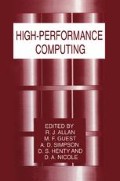Abstract
If ocean modellers are to continue doing useful research particularly in the area of global and climate modelling, it is essential that they effectively utilise today’s computing technology. Increasingly, this means parallel computers. To ease this transition, the Southampton - East Anglia model has been developed and is suitable for running in a wide range of configurations, on a wide range of platforms; from scalar workstations to clusters of workstations and massively parallel processor systems, rather than vector processors. Using high-level message passing routines the technical intricacies of parallelism are, as much as possible, hidden from the users, thus allowing them to concentrate on the ocean science, but at the same time enabling them to maximise the utilisation of whatever compute resources they have available to them.
Access this chapter
Tax calculation will be finalised at checkout
Purchases are for personal use only
Preview
Unable to display preview. Download preview PDF.
References
Beare M.I., 1996, SEA: Installation and User Guide, (see http://www.mth.uea.ac.uk/ocean/SEA).
Beare M.I. and Stevens D.P., 1997, Optimisation of a parallel ocean general circulation model, Annales Geophysicae 15:1369–1377.
Bryan K., 1969, A numerical method for the study of the circulation of the world ocean, Journal of Computational Physics 4:347–376.
Coward A.C., 1998, Experiences with a very high resolution global ocean model on a 512 processor Cray T3D, Physics and Chemistry of the Earth, in press.
Cox M.D., 1984, A primitive equation, three-dimensional model of the ocean, GFDL Ocean Technical Report No.1, Geophysical Fluid Dynamics Laboratory/NOAA, Princeton Univ., NJ.
Farrow D.E. and Stevens D.P., 1995, A new tracer advection scheme for Bryan and Cox type ocean global circulation models, Journal of Physical Oceanography 25:1731–1741.
Gwilliam C.S., Coward A.C., de Cuevas B.A., Webb D.J., Rourke E., Thompson, S.R. and Doos, K., 1995, The OCCAM global ocean model, Proceedings of the second UNAM-Cray Supercomputing Conference: Numerical Simulations in the Environmental and Earth Sciences, Mexico City.
Killworth P.D., Stainforth D., Webb D.J. and Paterson S.M., 1991, The development of a free-surface Bryan-Cox-Semtner ocean model, Journal of Physical Oceanography 21:1333–1348.
MPI Forum, 1994, MPI: a message passing interface standard, International Journal of Supercomputer Applications and High Performance Computing, Special Issue on MPI, 8 (3/4).
Pacanowski R.C., Dixon K. and Rosati A., 1991, The GFDL modular ocean model users guide: verion 1.0, GFDL Ocean Technical Report No.2, Geophysical Fluid Dynamics Laboratory/NOAA, Princeton Univ., NJ.
Pacanowski, R.C., 1995, MOM2 documentation, user’s guide and reference manual, GFDL Ocean Technical Report No.3, Geophysical Fluid Dynamics Laboratory/NOAA, Princeton Univ., NJ.
Sawdey A., 1995, O’Keefe M., Bleck R. and Numrich R.W., The design, implementation and performance of a parallel ocean circulation model, Proceedings of the Sixth ECMWF Workshop on the use of Parallel Processing in Meteorology, G. Hoffman and N. Kreitz, eds., World Scientific, 523–548.
Sunderam V.S., 1990, PVM: A framework for distributed parallel computing, Concurrency: Practice and Experience 2:315–339.
Webb D.J., 1996, An ocean model code for array processor computers, Computers and Geosciences 22:569–578.
Author information
Authors and Affiliations
Editor information
Editors and Affiliations
Rights and permissions
Copyright information
© 1999 Springer Science+Business Media New York
About this chapter
Cite this chapter
Beare, M.I. (1999). The Southampton - East Anglia (Sea) Model: A General Purpose Parallel Ocean Circulation Model. In: Allan, R.J., Guest, M.F., Simpson, A.D., Henty, D.S., Nicole, D.A. (eds) High-Performance Computing. Springer, Boston, MA. https://doi.org/10.1007/978-1-4615-4873-7_36
Download citation
DOI: https://doi.org/10.1007/978-1-4615-4873-7_36
Publisher Name: Springer, Boston, MA
Print ISBN: 978-1-4613-7211-0
Online ISBN: 978-1-4615-4873-7
eBook Packages: Springer Book Archive

